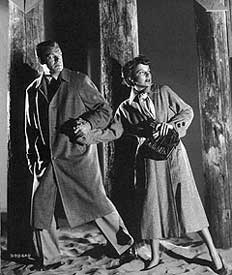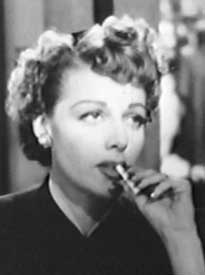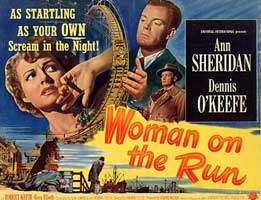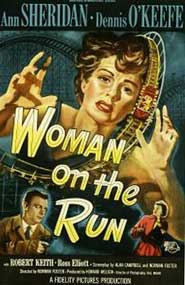 A dark outdoor stairway on a San Francisco hillside. A man in a trenchcoat walking his dog. In a car nearby, a hoodlum is demanding fifteen thousand dollars with which to get out of town. His companion finds it more expedient to shoot him. A dark outdoor stairway on a San Francisco hillside. A man in a trenchcoat walking his dog. In a car nearby, a hoodlum is demanding fifteen thousand dollars with which to get out of town. His companion finds it more expedient to shoot him.
The man with the dog sees the killer in the glow of a streetlamp, but we the viewers do not.
The killer takes careful aim & shoots into the darkness, at the silhouette of the witness, striking twice in the head. Fortunately for the witness, that silhouette was a sharp shadow cast by the same streetlamp.
When the police arrive, they reveal that the dead man was a witness in a mob case, & now our dog-walker, Frank Johnson (Ross Elliot), is their new witness. They want to take Frank into protective custody. But Frank ditches the police & & takes off into the night.
The police realize their witness is too nondescript for them to have much chance of locating him by discription alone. Frank was nondescript even to his wife Eleanor (Ann Sheridan), who possesses not even one photograph of her husband. She very soon realizes how little she knew Frank, with whom she had lived unlovingly a few years.
 One of the first things she finds out about Frank is he has a severe blood pressure problem & without medication is at some risk of a heart attack. The police are watching the pharmacies, so Frank's wife manages furtively to refill the prescription directly with the doctor, & sets out to find her husband. One of the first things she finds out about Frank is he has a severe blood pressure problem & without medication is at some risk of a heart attack. The police are watching the pharmacies, so Frank's wife manages furtively to refill the prescription directly with the doctor, & sets out to find her husband.
Dodging the police, her first try to find Frank is in Chinatown. Who she can't dodge is the newspaper reporter Danny Legget (Dennis O'Keffe), who wants an exclusive. She decides to let the reporter help her track down Frank, not realizing Danny is the killer.
Based on a short story by Sylvia Tate from the monthly American Magazine, the greater tone of the film is as gloomy film noir, but another thread of the tale is derived from romantic fiction such as was featured in leading magazines for housewives & parlors. Once Frank & Eleanor had been in love, but they lost that connection early in their marriage.
He's a painter who never quite made it in the world of arts. He closed himself off from his wife, who in consequence merely tolerated him with neither dislike nor affection.
But now, as she trails him in San Francisco dives & hang-outs, she learns from each friend of Frank's something about him she never knew, beginning with his heart condition, but many other things are revealed about his complex emotional landscape to which she had always been denied. And slowly she begins to remember why they fell in love in the first place.
 Everyone's fast-talking & smart-mouthed in this well-written script, Eleanor no less so than some of the men. Though the actors are second-string, they're good at what they do. Everyone's fast-talking & smart-mouthed in this well-written script, Eleanor no less so than some of the men. Though the actors are second-string, they're good at what they do.
A good story & excellent b/w cinematography add to a darned good film. And if occasionally the film seems to waver too much into the love-story angle, it always finds its way back to dark suspense, with fascinating character actors at every turn of the plot. There are odd little touches throughout, like the lush (Joan Shawlee) at a counter worried about hats, or a door left open merely because a shopkeeper insisted it be closed.
Frank has been assisted by friends in Chinatown, a performing team Sam & Susie (Victor Sen Yung & Rako Sato). The murder of Susie, tossed from a high window of a Chinatown club, is a shocking moment.
The climax, which takes place at night at a bayside carnival & midway (San Francisco's version of New York's Coney Island, the long lamented Playland), is extremely colorful. The midway provides great opportunities for lighting effects, plus a roller coaster ride of sheer tragic terror, when at last Eleanor is sorry to have evaded Inspector Ferris (Robert Keith).
Suspenseful to the last minute, Woman on the Run deserves greater fame than it has achieved as a classic film noir.
copyright © by Paghat the Ratgirl
|

